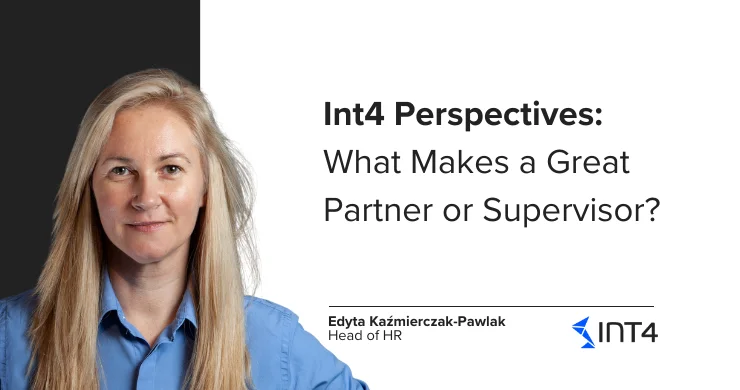In two years, from mentee to mentor and co-author of the SAP Press Book on Machine Learning.

My name is Donatella Nezereab and I am going to talk to Kinga Tarczyńska about her journey to becoming a mentor to celebrate January, which is Mentoring Month. I thought I would tell you a little bit about Kinga’s background before we get into the question part.
Kinga joined Int4 AG in the same year as I did, in 2020. Since then I have had the opportunity to watch her grow at the speed of light. From an ABAP developer when she joined Int4 AG, she has become an expert in ABAP, S/4HANA, BTP, CPI, and Int4 Suite; not to mention machine learning, which we will cover in our conversation below.
Donatella: Kinga, we have a Mentorship Culture at Int4 and we are encouraged on a daily basis to develop ourselves in the areas of hard and soft skills. What inspired the idea for you to co-author Machine Learning with Intelligent Scenario Lifecycle Management (ISLM)?
Kinga: Several factors have contributed to this. Firstly, I simply like to share my knowledge, and I get satisfaction from knowing that I have helped someone. I’ve been thinking about writing my own book for many years, but it wasn’t until now that I felt ready. Most importantly, the opportunity to collaborate with other authors came along.
Donatella: Oh yes, you mean the Book Club initiative at Int4 and the sessions on how to write a book with Michał Krawczyk, our mentor. So, what are your takeaways after writing your first book?
Kinga: Our e-bite was created together with my two colleagues from Int4 AG, Marek K. Zieliński and Marcin Dzierzgowski. The ability to work in a team was the key to the success of this project, especially when many of our tasks depended on the work of other team members. I would say that the values of Int4 stand out here: competences, relationships and balance. Work together as a team, share your knowledge and motivate each other – that’s it!
Donatella: And what about balance? How difficult is it to juggle writing a book with your daily responsibilities? Is there any way to prepare for it?
Kinga: A lot depends on how we work, whether we work full-time or not, whether we have additional responsibilities after work or at weekends, etc. Anything is possible, but remember that working evenings or weekends may be unavoidable.
Donatella: Now that you’ve said that, I wonder if it will be possible to write the first book without having to rely on more experienced writers?
Kinga: Absolutely, yes, someone had to be “the first”. But there is no denying that the whole process is much easier when you can ask a more experienced colleague who has been through the process before and can advise you. On the other hand, this is not to say that it is not worth trying if you are alone – it is worth it, and if you succeed, the joy and pride will be even greater!
Donatella: Let’s take a deeper dive into the book. Where did the idea of using machine learning in SAP come from? Are there real benefits to using ML in SAP projects or is it just a passing trend?
Kinga: Machine learning is inevitable. Sooner or later, directly or indirectly, every company will be using ML solutions. The benefits of ML solutions are huge, which is why they are becoming more and more popular. Many people may think that ML is a fad, but they do not realise that they are using ML unconsciously on a daily basis. Online shopping and recommendations, autocorrect on the keyboard, spam filters in our mailboxes – all thanks to AI and ML!
Donatella: For the technical reader, I know that to write a book like this, you need to have experience and exposure to the project in enterprise type companies so that you can later talk like an expert and write a book, right? From your experience, what are the technical and business benefits of using the ISLM framework in SAP S/4HANA?
Kinga: First, it provides a harmonised cockpit to manage scenarios based on SAP HANA ML (both APL and PAL libraries), as well as side-by-side scenarios where a machine learning artifact runs outside the SAP S/4HANA stack, such as SAP Business Technology Platform (SAP BTP). Traditionally, many tasks have been performed by separate teams using different tools. ISLM helps integrate these tasks using a common cockpit, standardising many tasks and speeding up the development and monitoring process. It supports both on-premises and cloud S/4HANA systems, and importantly, you don’t need an additional licence – it’s part of the SAP S/4HANA licence, ready to go.
Donatella: I can only hope that technical people will be satisfied with your answer. A non-technical person would probably like it explained in a simpler way. In the book you talk about how to develop a complete machine learning application for SAP S/4HANA using SAP HANA PAL. So how would you describe the above process to a 3 year old?
Kinga: Oh, it’s quite a challenge. (laughter and a sigh). Imagine the SAP HANA PAL (Machine Learning Library) is a box of magic scripts and spells. Instead of reinventing spells, you just find the right spell in the box and drop it into the cauldron where your ML app is boiling. You add a few extra magic spices and voila, your application is ready!
Donatella: Well, I did not have a child prodigy of SAP in mind at all. But if anyone feels like one, you recommend they dive in and read more about ML in the book you wrote, right? I think we can both recommend it: Machine Learning with Intelligent Scenario Lifecycle Management (ISLM), written by Marcin Dzierzgowski, Kinga Tarczyńska, Marek K. Zieliński.
Thank you Kinga for sharing your thoughts and experience with us!
Popular tags
ABAP int4 INT4 IFTT Int4Interview S/4HANA SAP AIF SAP CPI sap integration

